High Impact Tutoring Built By Math Experts
Personalized standards-aligned one-on-one math tutoring for schools and districts
In order to access this I need to be confident with:
Greatest common factor Prime factors Multiplying fractionsSimplifying fractions
Here you’ll learn about simplifying fractions, including a step by step guide to write fractions in their lowest terms using common factors.
Students will first learn about simplifying fractions as part of their work with the number system in middle school.
What is simplifying fractions?
Simplifying fractions is creating an equivalent fraction that uses a smaller numerator and denominator.
To do this you look at the numerator (the top number) and the denominator (the bottom number) and find a common factor that you can use to simplify the fraction. When a fraction can longer be simplified, it is called the lowest terms.
For example, the fraction \cfrac{5}{10} can be simplified to \cfrac{1}{2} since both the numerator and denominator have 5 as a factor.
\cfrac{5 \, \div \, 5}{10 \, \div \, 5}=\cfrac{1}{2}

\cfrac{1}{2} is the lowest terms of \cfrac{5}{10}.
What is simplifying fractions?
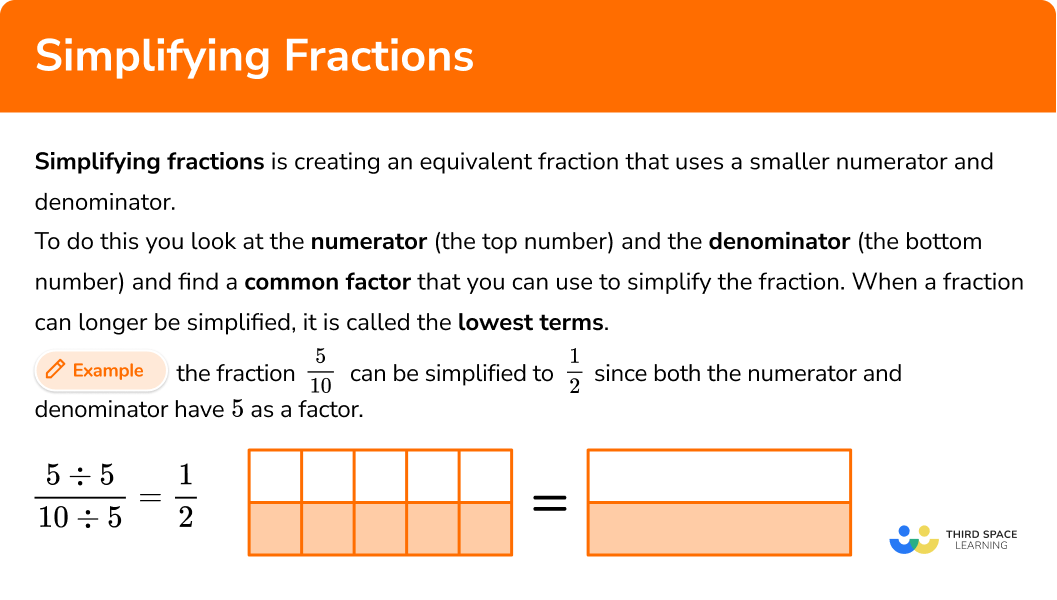
Common Core State Standards
How does this relate to 4th grade math and 6th grade math?
- Grade 4: Numbers & Operations – Fractions (4.NF.A.1)
Explain why a fraction \cfrac{a}{b} is equivalent to a fraction \cfrac{n \times a}{n \times b} by using visual fraction models, with attention to how the number and size of the parts differ even though the two fractions themselves are the same size. Use this principle to recognize and generate equivalent fractions.
- Grade 6: The Number System (6.NS.B.4)
Find the greatest common factor of two whole numbers less than or equal to 100.
How to simplify fractions
In order to simplify fractions using common factors:
- Divide the numerator and denominator by the first common factor.
- Continue dividing by common factors until \bf{1} is the only common factor.
- Write the fraction in lowest terms.
In order to simplify fractions using GCF:
- Find the greatest common factor (GCF) of the numerator and denominator.
- Divide both the numerator and the denominator by the GCF.
- Write the fraction in lowest terms.
![[FREE] Simplifying Fractions Worksheet (Grade 6)](https://thirdspacelearning.com/wp-content/uploads/2023/11/Simplifying-Fractions-Worksheet-listing-image.png)
[FREE] Simplifying Fractions Worksheet (Grade 6)
![[FREE] Simplifying Fractions Worksheet (Grade 6)](https://thirdspacelearning.com/wp-content/uploads/2023/11/Simplifying-Fractions-Worksheet-listing-image.png)
Use this worksheet to check your grade 6 students’ understanding of simplifying fractions. 15 questions with answers to identify areas of strength and support!
DOWNLOAD FREE![[FREE] Simplifying Fractions Worksheet (Grade 6)](https://thirdspacelearning.com/wp-content/uploads/2023/11/Simplifying-Fractions-Worksheet-listing-image.png)
[FREE] Simplifying Fractions Worksheet (Grade 6)
![[FREE] Simplifying Fractions Worksheet (Grade 6)](https://thirdspacelearning.com/wp-content/uploads/2023/11/Simplifying-Fractions-Worksheet-listing-image.png)
Use this worksheet to check your grade 6 students’ understanding of simplifying fractions. 15 questions with answers to identify areas of strength and support!
DOWNLOAD FREESimplifying fractions examples
Example 1: simplifying fractions using common factors
Write \cfrac{36}{40} in lowest terms.
- Divide the numerator and denominator by the first common factor.
Since both 36 and 40 are even, the first common factor is 2.
\cfrac{36 \, \div \, 2}{40 \, \div \, 2}=\cfrac{18}{20}
2Continue dividing by common factors until \bf{1} is the only common factor.
Since both 18 and 20 are even, you can divide by 2 again.
\cfrac{18 \, \div \, 2}{20 \, \div \, 2}=\cfrac{9}{10}
The only common factor of 9 and 10 is 1.
3Write the fraction in lowest terms.
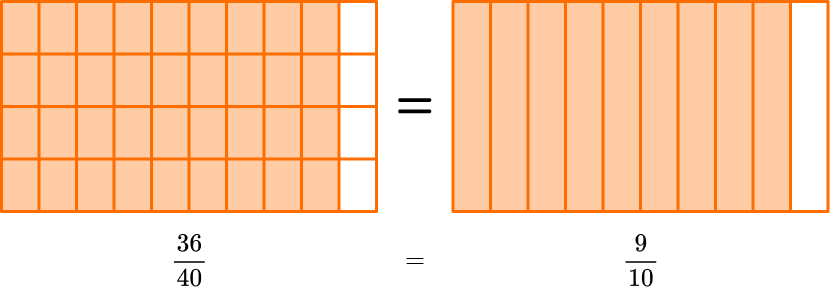
\cfrac{36}{40} in lowest terms is \cfrac{9}{10}.
Example 2: simplifying fractions using common factors
Write in \cfrac{42}{60} lowest terms.
Divide the numerator and denominator by the first common factor.
Since both 42 and 60 are even, the first common factor is 2.
\cfrac{42 \, \div \, 2}{60 \, \div \, 2}=\cfrac{21}{30}
Continue dividing by common factors until \bf{1} is the only common factor.
Since both 21 and 30 have a factor of 3, you can divide by 3.
\cfrac{21 \, \div \, 3}{30 \, \div \, 3}=\cfrac{7}{10}
The only common factor of 7 and 10 is 1.
Write the fraction in lowest terms.
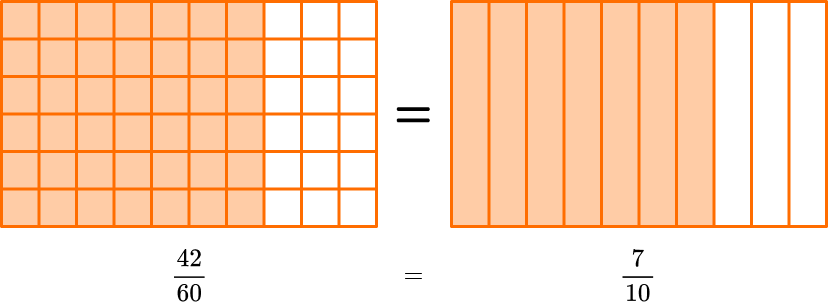
\cfrac{42}{60} in lowest terms is \cfrac{7}{10}.
Example 3: simplifying fractions using common factors
Write \cfrac{60}{80} in lowest terms.
Divide the numerator and denominator by the first common factor.
Since both 60 and 80 are even, the first common factor is 2.
\cfrac{60 \, \div \, 2}{80 \, \div \, 2}=\cfrac{30}{40}
Continue dividing by common factors until \bf{1} is the only common factor.
Since both 30 and 40 are even, you can divide by 2.
\cfrac{30 \, \div \, 2}{40 \, \div \, 2}=\cfrac{15}{20}
Since both 15 and 20 have a factor of 5, you can divide by 5.
\cfrac{15 \, \div \, 5}{20 \, \div \, 5}=\cfrac{3}{4}
The only common factor of 3 and 4 is 1.
Write the fraction in lowest terms.
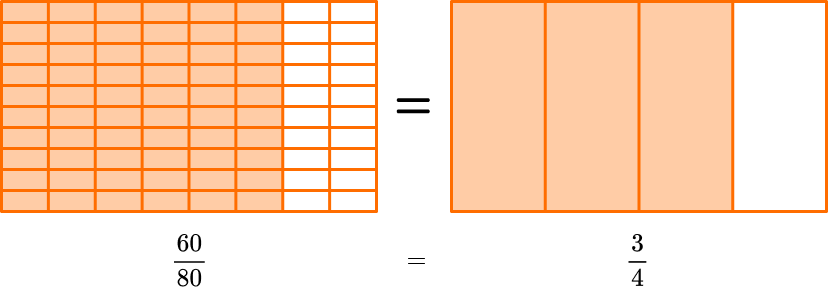
\cfrac{60}{80} in lowest terms is \cfrac{3}{4}.
Example 4: simplifying fractions with a non-prime GCF
Write \cfrac{36}{81} in lowest terms.
Find the greatest common factor (GCF) of the numerator and denominator.
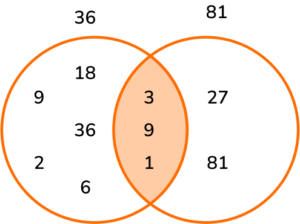
The greatest common factor of 36 and 81 is 9.
Divide both the numerator and the denominator by the GCF.
\cfrac{36 \, \div \, 9}{81 \, \div \, 9}=\cfrac{4}{9}
Write the fraction in lowest terms.
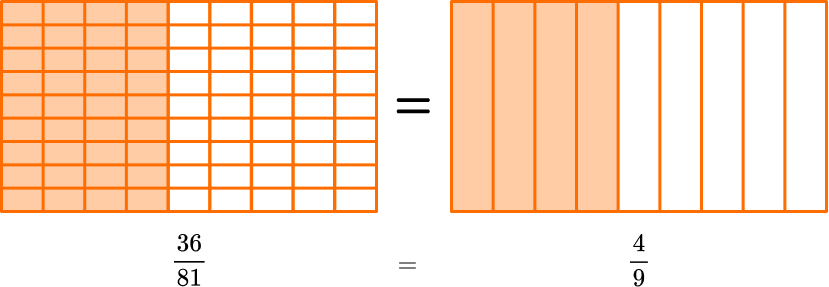
\cfrac{36}{81} in lowest terms is \cfrac{4}{9}.
Example 5: simplifying fractions with a prime number GCF
Write \cfrac{15}{40} in lowest terms.
Find the greatest common factor (GCF) of the numerator and denominator.
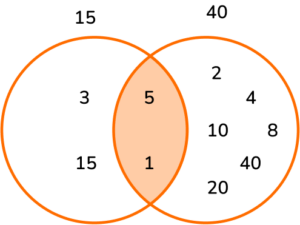
The greatest common factor of 15 and 40 is 5.
Divide both the numerator and the denominator by the GCF.
\cfrac{15 \, \div \, 5}{40 \, \div \, 5}=\cfrac{3}{8}
Write the fraction in lowest terms.

\cfrac{15}{40} in lowest terms is \cfrac{3}{8}.
Example 6: simplifying fractions with a non-prime GCF
Write \cfrac{65}{110} in lowest terms.
Find the greatest common factor (GCF) of the numerator and denominator.
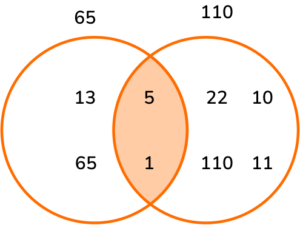
The greatest common factor of 65 and 110 is 5.
Divide both the numerator and the denominator by the GCF.
\cfrac{65 \, \div \, 5}{110 \, \div \, 5}=\cfrac{13}{22}
Write the fraction in lowest terms.
\cfrac{65}{110}=\cfrac{13}{22}
\cfrac{65}{110} in lowest terms is \cfrac{13}{22}.
Teaching tips for simplifying fractions
- In the beginning, use models to reinforce the equivalence between the original fraction and the fraction in lowest terms.
- Expose students to real world situations where the fraction in lowest terms is more useful than the original fraction. For example, (when multiplying fractions or adding fractions for word problems that represent inches. The answer may need to be simplified back to a fraction with a denominator that appears on a ruler.)
- Show students a group of fractions that is equivalent to a benchmark (like \cfrac{1}{4} ) and have them discuss any patterns they see. This will help students start to recognize lowest term fractions without having to calculate.
- To assist struggling students recall multiplication facts, provide them with a multiplication chart.
Our favorite mistakes
- Simplifying to non-integer numerators or denominators
The numerator and denominator of a fraction must both be integers (a positive or negative whole number). The final answer can not have decimals or be a fraction within a fraction.
- Thinking that you can only simplify with the GCF
You can simplify a fraction by using any of the common factors of the numerator and the denominator of a fraction. Simplifying the fraction by the GCF will get the fraction in its lowest terms quickest.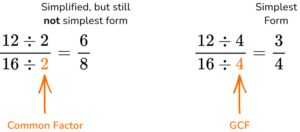
Practice simplifying fractions questions
1. Write \cfrac{3}{12} in lowest terms.




For 3 and 12, the first common factor is 3. This is also the GCF.
\cfrac{3 \, \div \, 3}{12 \, \div \, 3}=\cfrac{1}{4}
The only common factor of 1 and 4 is 1.
\cfrac{3}{12} in its lowest terms is \cfrac{1}{4}.
2. Write \cfrac{15}{35} in lowest terms.




For 15 and 35, the first common factor is 5. This is also the GCF.
\cfrac{15 \, \div \, 5}{35 \, \div \, 5}=\cfrac{3}{7}
The only common factor of 3 and 7 is 1.
\cfrac{15}{35} in its lowest terms is \cfrac{3}{7}.
3. Write \cfrac{20}{120} in lowest terms.




Since both 20 and 120 are even, the first common factor is 2.
\cfrac{20 \, \div \, 2}{120 \, \div \, 2}=\cfrac{10}{60}
Both 10 and 60 are even, so they can be divided by 2.
\cfrac{10 \, \div \, 2}{60 \, \div \, 2}=\cfrac{5}{30}
Both 5 and 30 have a common factor of 5, so they can be divided by 5.
\cfrac{5 \, \div \, 5}{30 \, \div \, 5}=\cfrac{1}{6}
Also, for 20 and 120, the GCF is 20.
\cfrac{20 \, \div \, 20}{120 \, \div \, 20}=\cfrac{1}{6}
The only common factor of 1 and 6 is 1.
\cfrac{20}{120} in its lowest terms is \cfrac{1}{6}.
4. Write \cfrac{45}{135} in lowest terms.




The first common factor of 45 and 135 is 5, so they can be divided by 5.
\cfrac{45 \, \div \, 5}{135 \, \div \, 5}=\cfrac{9}{27}
Both 9 and 27 have a common factor of 6, so they can be divided by 6.
\cfrac{9 \, \div \, 3}{27 \, \div \, 3}=\cfrac{3}{9}
Both 3 and 9 have a common factor of 3, so they can be divided by 3.
\cfrac{3 \, \div \, 3}{9 \, \div \, 3}=\cfrac{1}{3}
Also, for 45 and 135, the GCF is 45.
\cfrac{45 \, \div \, 45}{135 \, \div \, 45}=\cfrac{1}{3}
The only common factor of 1 and 3 is 1.
\cfrac{45}{135} in its lowest terms is \cfrac{1}{3}.
5. Write \cfrac{20}{44} in lowest terms.




Since both 20 and 44 are even, the first common factor is 2.
\cfrac{20 \, \div \, 2}{44 \, \div \, 2}=\cfrac{10}{22}
Both 10 and 22 have a common factor of 2, so they can be divided by 2.
\cfrac{10 \, \div \, 2}{22 \, \div \, 2}=\cfrac{5}{11}.
Also, for 20 and 44, the GCF is 4.
\cfrac{20 \, \div \, 4}{44 \, \div \, 4}=\cfrac{5}{11}
The only common factor of 5 and 11 is 1.
\cfrac{20}{44} in its lowest terms is \cfrac{5}{11}.
6. Write \cfrac{84}{91} in lowest terms.




For 84 and 91, the first common factor is 7. This is also the GCF.
\cfrac{84 \, \div \, 7}{91 \, \div \, 7}=\cfrac{12}{13}
The only common factor of 1 and 3 is 1.
\cfrac{84}{91} in its lowest terms is \cfrac{12}{13}.
Simplifying fractions FAQs
No, when you simplify fractions you use an equivalent fraction with larger parts (and therefore smaller numbers) to represent the same fraction.
Sometimes it is used to make fractions more recognizable (ex. \cfrac{1}{2} is more common than \cfrac{100}{200}). Other times it is used to make fractions simpler to work with (hints the name).
Not necessarily. There may be times when the original fraction is used or even required. For example, when converting from fractions to decimals, you would not want to simplify \cfrac{58}{100}, since 100ths is a decimal position.
No, the same steps can be followed to simplify mixed numbers and improper fractions.
The next lessons are
Still stuck?
At Third Space Learning, we specialize in helping teachers and school leaders to provide personalized math support for more of their students through high-quality, online one-on-one math tutoring delivered by subject experts.
Each week, our tutors support thousands of students who are at risk of not meeting their grade-level expectations, and help accelerate their progress and boost their confidence.

Find out how we can help your students achieve success with our math tutoring programs.
[FREE] Common Core Practice Tests (3rd to 8th Grade)
Prepare for math tests in your state with these 3rd Grade to 8th Grade practice assessments for Common Core and state equivalents.
Get your 6 multiple choice practice tests with detailed answers to support test prep, created by US math teachers for US math teachers!